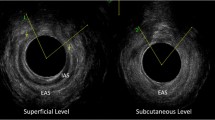Abstract
Introduction and hypothesis
To determine if the classification of obstetric anal sphincter injuries (OASIs) affected clinical and functional outcome and to assess the need for follow-up of 3a tears in secondary care
Methods
Prospective data collection in 255 patients who sustained OASIs during repair with follow-up in a specialist clinic after 6 months.
Results
One hundred and thirty-two patients (51.7 %) sustained 3a tears, 81 (31.7 %) 3b tears, 27 (10.6 %) 3c tears and 15 (5.8 %) had 4th degree tears. Twenty-three patients (9 %) reported symptoms at 6-month follow-up. Eight patients reported anal incontinence of liquid or solid stool. Among patients who sustained 3a tears, 8 patients were symptomatic: 7 had urgency and 1 had flatus incontinence. None of the patients who sustained 3a tears reported incontinence of solid/liquid stool. There appears to be no correlation with scan findings and symptoms at follow up. Most patients are asymptomatic. Urgency of faeces is the commonest symptom.
Conclusions
The vast majority of patients are asymptomatic. The necessity of seeing all these patients in secondary care for follow-up needs to be questioned. With effective primary care follow-up, there may be a place to follow up patients with 3a tears in the community during the routine 6-week postnatal check and refer the symptomatic patients to the hospital for further review.
Similar content being viewed by others
References
McClandish R, Bowler U, van Asten H et al (1998) A randomised controlled trial of care of the perineum during second stage of normal labour. Br J Obstet Gynaecol 105:1262–1272
Rao SS (2004) Diagnosis and management of faecal incontinence. Am J Gastroenterol 99:1585–1604
Christianson LM, Bovbjerg VE, McDavitt EC, Hullfish KL (2003) Risk factors for perineal injury during delivery. Am J Obstet Gynecol 189(1):255–260
Laine K, Gissler M, Pirhoen (2009) Changing incidence of anal sphincter tears in four Nordic countries through the last decades. Eur J Obstet Gynecol Reprod Biol 146(1):71–75
Faltin DL, Boulvain M, Irion O, Bretones S, Stan C, Weil A (2000) Diagnosis of anal sphincter tears by postpartum endosonography to predict faecal incontinence. Obstet Gynecol 95:643–647
McLeod NL, Gilmour DT, Joseph KS, Farrell SA, Luther ER (2003) Trends in major risk factors for anal sphincter lacerations: a 10 year study. J Obstet Gynecol Can 25:586–593
Cunningham CB, Pilkington JW (1955) Complete perineotomy. Am J Obstet Gynecol 70:1225–1231
Fenner DE, Genberg B, Brahma P, Marek L, DeLancey JO (2003) Fecal and urinary incontinence after vaginal delivery with anal sphincter disruption in an obstetrics unit in the United States. Am J Obstet Gynecol 189(6):1543–1549
Kamm MA (1998) Faecal incontinence. BMJ 316:528–532
Haadem K, Ohrlander S, Lingman G, Dahlström JA (1989) Successful late repair of anal sphincter rupture caused by delivery. Acta Obstet Gynecol Scand 68(6):567–569
Sultan AH, Monga AK, Kumar D, Stanton SL (1999) Primary repair of obstetric anal sphincter rupture using the overlap technique. Br J Obstet Gynaecol 106(4):318–323
Fitzpatrick M, Behan M, O’Connell PR, O’Herlihy C (2000) A randomized clinical trial comparing primary overlap with approximation repair of third-degree obstetric tears. Am J Obstet Gynecol 183(5):1220–1224
Hayes J, Shatari T, Toozs-Hobson P, Busby K, Pretlove S, Radley S, Keighley M (2007) Early results of immediate repair of obstetric third-degree tears. Colorectal Dis 9(4):332–336
Fernando RJ, Sultan AH, Radley S, Jones PW, Johanson RB (2002) Management of obstetric anal sphincter injury: a systematic review & national practice survey. BMC Health Serv Res 2:9
Royal College of Obstetricians and Gynaecologists (2007) Management of third and fourth degree tears. Green top guideline no. 29. RCOG, London
Oberwalder M, Connor J, Wexner SD (2003) Meta-analysis to determine the incidence of obstetric anal sphincter damage. Br J Surg 90:1333–1337
Groom KM, Paterson-Brown S (2002) Can we improve on the diagnosis of third degree tears? Eur J Obstet Gynecol Reprod Biol 101:19–21
Andrews V, Sultan AH, Thakar R, Jones PW (2006) Occult anal sphincter injuries: myth or reality? BJOG 113:195–200
Dudding TC, Vaizey CJ, Kamm MA (2008) Obstetric anal sphincter injury: incidence, risk factors, and management. Ann Surg 247(2):224–237
Johanson RB, Heycock E, Carter J, Sultan AH, Walklate K, Jones PW (1999) Maternal and child health after assisted vaginal delivery: five-year follow up of a randomised controlled study comparing forceps and ventouse. BJOG 106:544–546
Andrews V, Thakar R, Sultan AH (2009) Outcome of obstetric anal sphincter injuries (OASIS)—role of structured management. Int Urogynecol J Pelvic Floor Dysfunct 20(8):973–978
Conflicts of interest
None.
Author information
Authors and Affiliations
Corresponding author
Additional information
Institutional review board process: Prospective permission was obtained from the clinical effectiveness team at University of Southampton NHS Hospital Trust and agreed to perform the data collection through the clinical audit process
Rights and permissions
About this article
Cite this article
Ramalingam, K., Monga, A.K. Outcomes and follow-up after obstetric anal sphincter injuries. Int Urogynecol J 24, 1495–1500 (2013). https://doi.org/10.1007/s00192-013-2051-9
Received:
Accepted:
Published:
Issue Date:
DOI: https://doi.org/10.1007/s00192-013-2051-9




